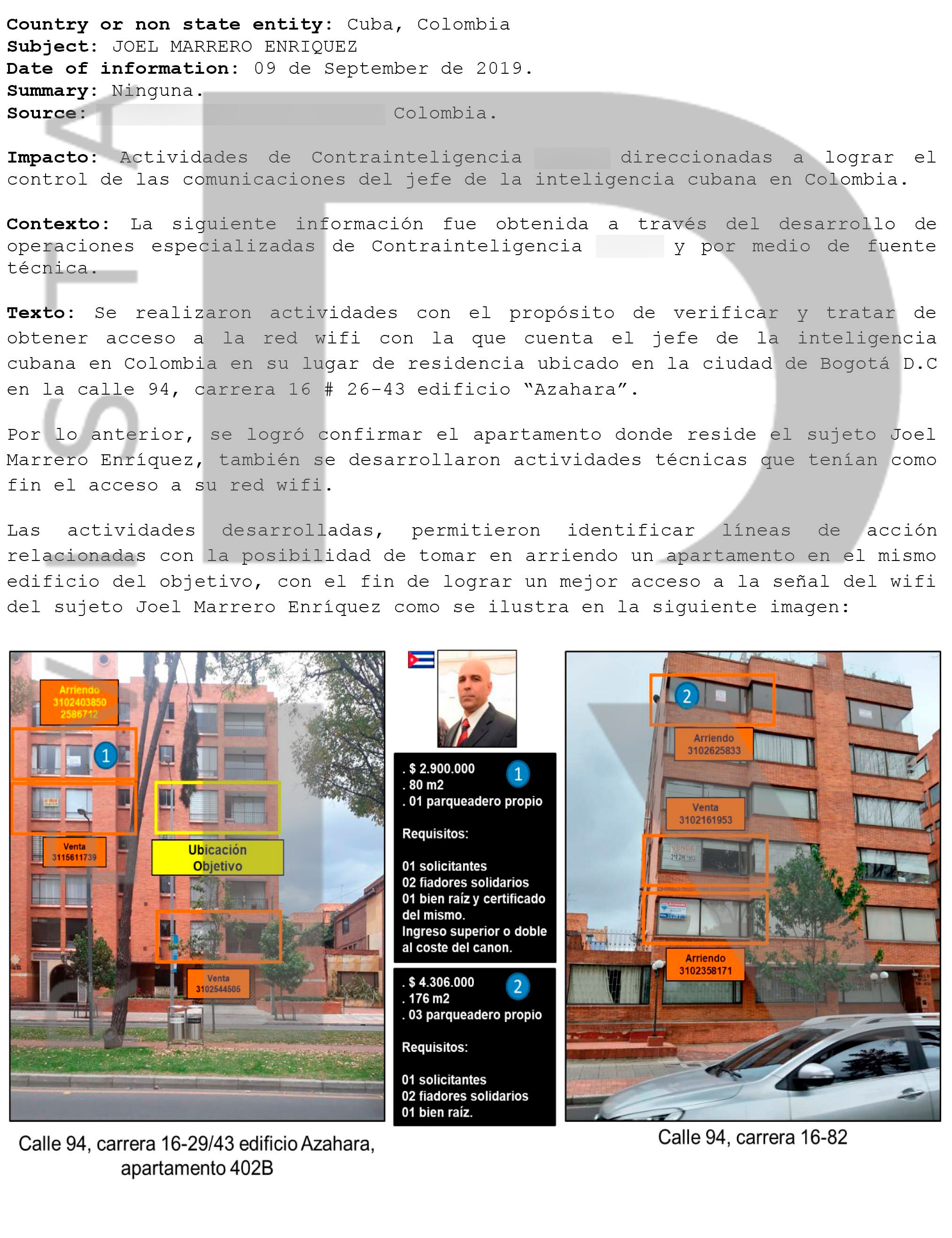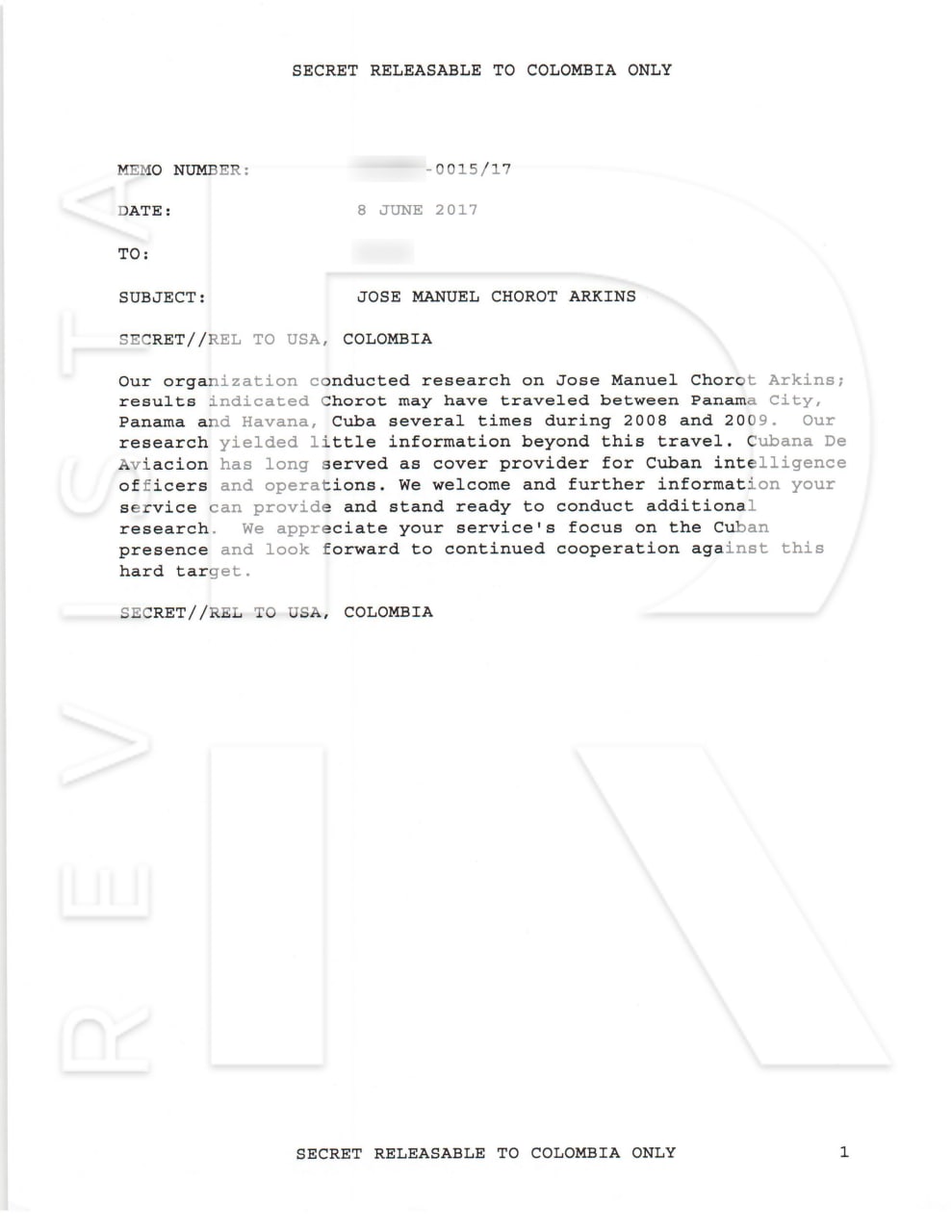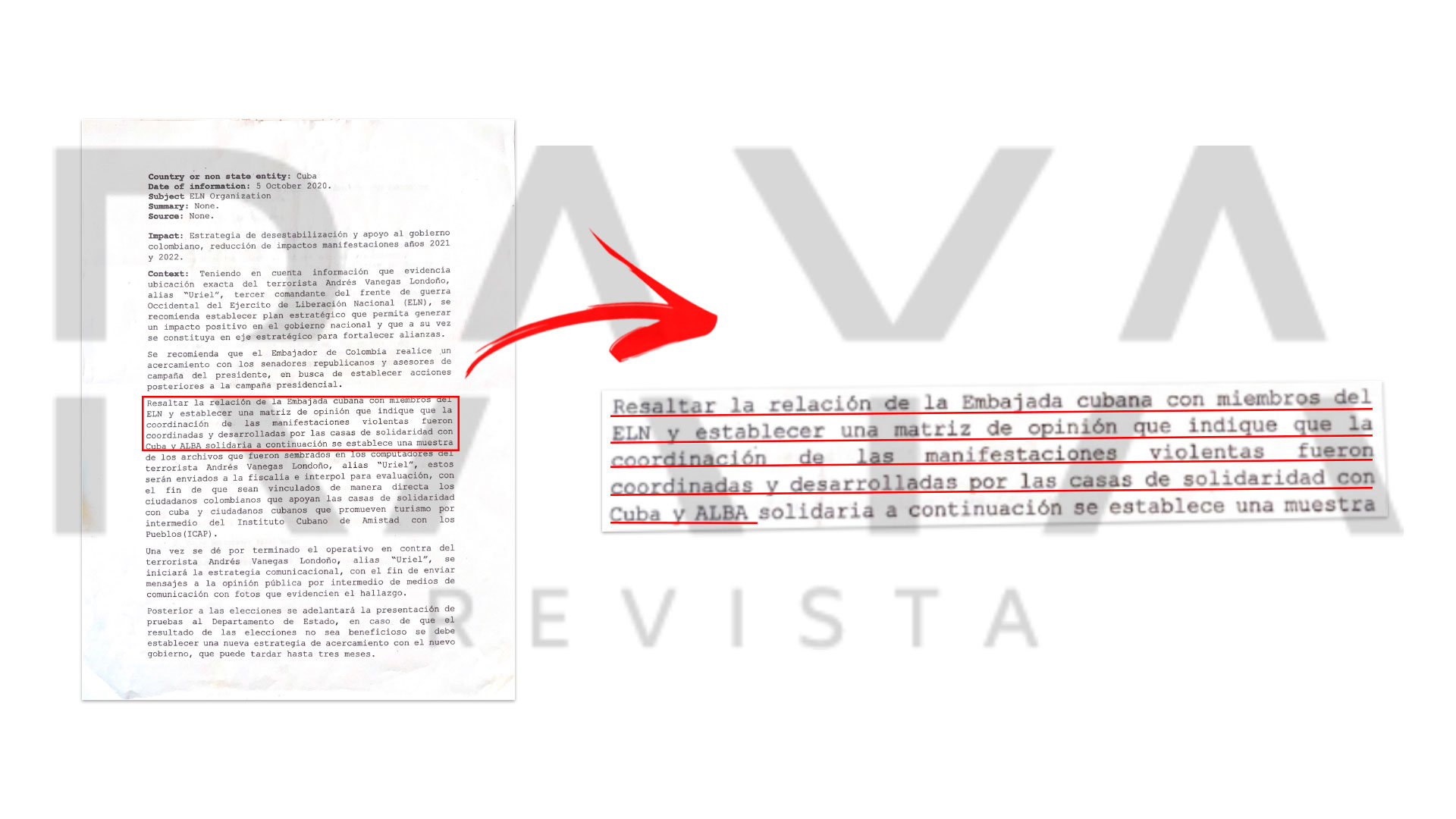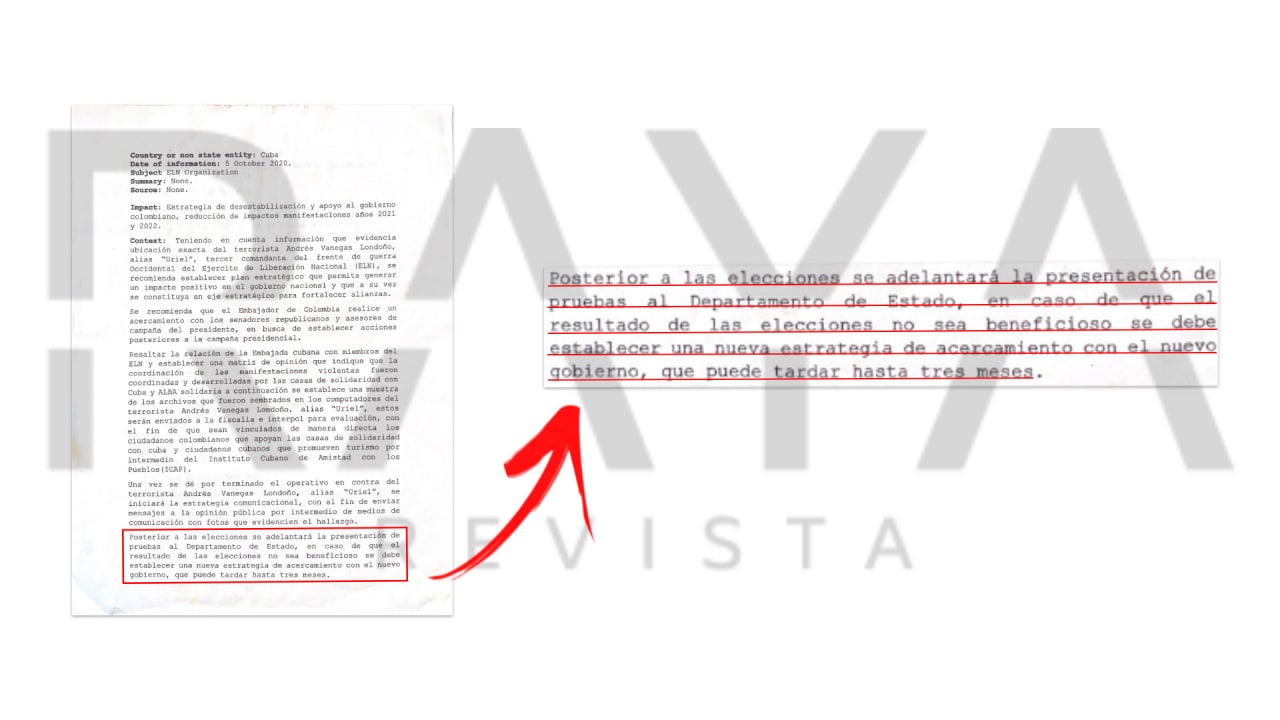Espionaje Internacional: Objetivo Cuba
Espionage folders are full of profiles, photographs, sketches, follow-up videos, maps, chessboards and the most unusual names to identify operations. The “Charlie” target was the name given to the espionage operation against the Cuban government, including its diplomatic corps in Colombia, whose members were accused of being spies to justify obtaining official money, follow them and control their political meetings with the Colombian and Latin American left, and social leaders. Through this intelligence service, Colombian spies even had access to privileged documents of military exchange agreements between Venezuela and Cuba.
There are also documents in which it was admitted they “planted” evidence in the computers of a guerrilla leader to incriminate the Cuban government of having an alleged complicity with the ELN in violent acts during the social protest.
The Cuban chapter began on September 26, 2016 with the arrival in Cartagena de Indias, Colombia, of 162 members of the island’s government. Between consuls, journalists, doctors, security agents of President Raúl Castro Ruz and guarantors of the peace process with the FARC, when the agreement would be signed in that coastal city. That list gave rise to hundreds of operations being launched over five years.
On April 11, 2017, for example, a report from this intelligence agency recorded the entry route and internal photos of the Cuban Embassy building, located in the Chicó neighborhood, in the north of Bogotá. This information was provided by a human source, co-opted by a former agent of the disappeared Administrative Department of Security (DAS). The source had been working with the military intelligence agency for three years under the guise of his work as a journalist and photographer, which allowed him to gain the trust of some Cuban officials. “Details in the waiting room: round glass table, round corrugated glass ashtray, painting of Che Guevara and Fidel Castro, black synthetic leather sofa, pot in the corner of the waiting room”, points to the document that contains seven screenshots of a video recorded by the infiltrator journalist, a man in his 60s. Weeks later, the agents located and outlined the new residence of the then Cuban ambassador José Luis Ponce Caraballo.
[All the images and documents revealed in this article correspond to the original files of the intelligence agency.]
Little by little, the Colombian spies, without a court order, developed surveillance and monitoring of Cuban diplomats, infiltrating political meetings and commemorations of the Cuban Revolution. In these follow-ups, they not only took photographs to profile the attendees, but also penetrated the communications of Ambassador Ponce. This happened on November 17, 2017 at the Hotel Versalles in Barranquilla, where the XXVI Meeting of Solidarity with Cuba was held, when an infiltrated agent posing as an Ecopetrol official installed a device that tracked the wireless internet signals. As can be seen in the following image, he was able to access Ambassador Ponce’s email and password.
On December 5, 2017, the “Achilles” operation was activated, which was nothing more than carrying out physical surveillance of several Cuban diplomats. One of them was Eric Sosa Frutos, Cuban vice-consul in Colombia, who traveled to Cali that day along with his replacement, Kendry Sosa. Both were followed from the El Dorado airport until they landed at the Alfonso Bonilla Aragón airport in Cali. They then followed them to the La Boquería restaurant, located in the south of the capital of the Valley. There, according to the photos taken by the spy agents and their story, “they hold a meeting with a subject of Cuban nationality identified as Alejandro Pavel Vidal, who has worked in the city of Cali as a professor at the Javeriana University since 2012,” says the intelligence report.
Pavel is Cuban, but he has lived in Colombia for more than two decades. The maximum profile they managed to make of him was that he did a doctorate in economics at the University of Havana and that he studied at Columbia and Harvard universities. However, the intelligence agency located the address of his home in Cali, he took photographs of the residential complex and the license plates of his vehicle.
After the meeting, the Colombian spies followed the Cuban vice-consuls when they went to the Plaza Las Américas hotel, located in northern Cali, “where they are about to walk through the sector,” says the report. They were also followed the next day when they took a vehicle to the airport, entered the waiting room, and returned to Bogotá on the night of December 6, 2017.
Days later, the same Colombian spies, through the infiltration of the collaborating photojournalist, photographed and profiled different personalities who attended the farewell of embassy officials at the Museo del Chicó, in the north of Bogotá. In the photographs highlighted in the intelligence reports, the person who was taking over as the new deputy chief of the Cuban mission in Colombia, Omar García Lazo, and the political attaché Joel Marrero Enríquez were outlined. In addition, the spies highlighted in their reports the presence at the event of the journalist Enrique Santos Calderón, brother of President Juan Manuel Santos, who was in office and had just signed the Peace Agreement with the FARC-EP that was negotiated in Havana with the determined support of the Cuban government. “Possible Cuban intelligence agent Joel Marrero Enríquez, Colombian journalist and writer Enrique Santos Calderón,” it says under the photo in which they appear hugging and smiling.

In January 2018, the infiltration of the social events of Cuban diplomats continued. The agents infiltrated the commemoration of the birth of José Martí that took place in the hall of the Community Action Board of the Policarpa neighborhood, in the south of Bogotá. The agents took advantage of the appointment to continue following and profiling Ambassador Ponce, his security personnel, José Manuel Chorot Arkins —commercial representative of the Cubana de Aviación company— and the aforementioned Joel Marrero Enríquez. As can be seen in the images, not only were the diplomats photographed with long-lens cameras, but the serial numbers of their vehicle plates were also recorded.
Profiling Assistants to embassy
Profiling embassy assistant cars
By April 2018, the intelligence agency already had the complete map of the contacts with whom Marrero spoke in full implementation of the Peace Agreement with the FARC-EP and the development of the dialogues with the ELN in Cuba. The map that we show in this report reflects the level of espionage, trailing and profiling carried out by the military intelligence agency in conjunction with the National Intelligence Directorate (DNI), a dependency of the Presidency of the Republic. Marrero’s cell phone had been intercepted since February 23, 2017, often nicknamed disparagingly, in the reports and analyzes of the agents, as “marrano”.
According to the organization chart, the Colombian spies listened to hundreds of conversations that Marrero had with different personalities from Colombian politics, journalists from Prensa Latina who are accused of being spies, Joshua Goodman (American journalist from the Associated Press), social leaders and even the director of the DNI, Admiral Álvaro Echandía Durán. The DNI itself was part of this operation by listening to the calls between Marrero and Echandía and another 62 calls that the soldier made that day, even though he was the top leader of those who spied on him.
Interception to the director of the DNI:
In that organizational chart of the intercepted calls, Ambassador José Luis Ponce also appears, with his cell phone numbers; Vice Consul Kendry Sosa; Senator Iván Cepeda; the social leader and current senator from the left, Gloria Flórez; the general secretary of the Colombian Communist Party, Jaime Castro Turriago; the lawyer of the former FARC-EP guerrilla, Diego Martínez; the photojournalist Gerald Bermúdez and even the late journalist Carlos Lozano Guillén, director of the Voz Weekly, as well as other social leaders from Colombia and Cuba and members of the Solidarity Committee.
Map of interceptions to Joel Marrero
Marrero became a constant target for the intelligence agency, whom they managed to infiltrate through sophisticated equipment to violate his private communications. At the end of 2018, between November and December, the internet network of his apartment was penetrated from an antenna located in a van with tinted windows parked in an adjoining parking lot. From there, the Colombian spies sent the signal to the Advanced Operations Site (SOA), located in an apartment they rented for 2,900,000 pesos a month on Calle 94 with Carrera 18, a few blocks from the diplomat’s apartment.

Four cell phones and a computer belonging to Marrero and his wife Giselle Cuadra Denis were intercepted. The meticulous and constant monitoring was repeated in May and December 2019, as was recorded in one of the reports that also describes the modus operandi of the Colombian spies: “A comparison was made of the Handshake [technology that allows extracting the keys from a foreign computer) obtained in the month of December 2018 and the month of May 2019, but it is identified that they have changed, which indicates that the password to access the Wi-Fi network of Joel Marero [sic] changed to date, for this reason it is necessary to decrypt the current Handshake as soon as possible to obtain access to the network”.
Map of interceptions operations
Map of interceptions operations
Map of interceptions operations
Evidence development field operations
Scheme devices intercepted residence Joel Marrero
Computer profiling Joel Marrero
Evidence hacking of computer keys Joel Marrero
Despite the infiltration and penetration capacity achieved by Colombian spies for more than five years, the reports do not report evidence that put Marrero as the spy they presumed. In addition, there was never a court order to carry out this violation of the diplomat’s privacy.
In the folders of the target “Charlie” there are documents in English that say “SECRET/REL TO USA, COLOMBIA” and that, according to the source that gave the information to RAYA magazine, come from US intelligence agents. “Our service conducted an investigation into the individuals listed below who are currently assigned to the Cuban Embassy in Bogotá in an effort to identify targets of interest, specifically those with ties to Cuban intelligence. Aside from Marrero and Sosa, our initial investigation suggests that Second Secretary Rolando Ruiz Abrahantes and Guillermo Francisco Trevejo Pérez may be associated in some way with the Cuban Intelligence Directorate (DI).
Ambassador Ponce is not mentioned in the American reports. On the other hand, about José Manuel Chorot Arkins, commercial representative of Cubana de Aviación, it is said that the only thing they found were the reports of two trips between Havana and Panama in 2008 and 2009.
US profiling of Cuban officials
With these documents, what is clear is that United States agents were also very interested in obtaining information about Cuban diplomats in Colombia. “We appreciate any additional information your service can provide and stand ready to conduct further investigation. We appreciate the focus of your service on the Cuban presence and look forward to continuing cooperation against this difficult target.”

Despite the profiling and monitoring, the Colombian agents did not obtain evidence to show that Cuba was carrying out espionage operations. Rather, reports suggest, through Cold War language, that the reasons for continuing to spy on Cuban diplomats are political. For example, the spread of communism was branded as something dangerous for the stability of Colombia and Latin America, and social organizations were accused of being indoctrinators of “Castro ideology.” This, despite the fact that Intelligence Law 1621 of 2013 prohibits conducting intelligence for “reasons of gender, race, national or family origin, language, religion, political or philosophical opinion, membership of a trade union, social or human rights organization,”
Five years after the start of operations against the objective “Charlie”, Omar García Lazo, deputy head of the Cuban mission, was expelled without specific explanations by the Colombian Foreign Ministry. In May 2021, the Foreign Ministry declared Lazo persona non grata because allegedly “he was carrying out activities in the country incompatible with the provisions of the Vienna Convention on Diplomatic Relations”, he was even presented in the media as a Cuban spy. However, in the more than a thousand files obtained by RAYA magazine, there is no evidence to indicate that Lazo had been carrying out illegal activities in Colombian territory. In fact, there is no judicial order that supported the detailed espionage of him and his family.
“Access was gained to an event held on July 11, 2019 at the facilities of the National University of Colombia located in Bogotá, in which Omar Rafael García Lazo, alleged Cuban intelligence agent, who serves as second chief of the diplomatic Mission of Cuba in Colombia and in turn is in charge of directing the support network for external intelligence in Colombia. During the event it was possible to observe that the aforementioned subject was in charge of directing the event and in which he defamed the presence of the United States mission in Colombia,” says one of the documents in which he is profiled.
Infiltration in Havana
The intelligence agency was clear that it was following leaders of social and political organizations in Colombia and Cuba, but it was legitimizing its actions under the assumption that a transnational network was being formed that intended to attack the validity of the Colombian democratic regime through the promotion of “the free self-determination of the peoples and the promotion of the ideology of the revolution”. This was recorded in the “Apolo” operation, an international infiltration strategy that was planned on September 14, 2017 and consisted of the displacement of a human source to the “Julio Antonio Mella” International Camp (CIJAM), located in the municipality of Caimito, 45 kilometers from Havana. Its objective:
Due to logistical failures, this operation was not completed because the human source did not get a spot to travel to Havana. In any case, the intelligence agency ordered the profiling and violation of the communications of the person in charge of summoning the traveling personnel and leader of that brigade: Isaías Garzón, president of the Bogotá District Employees and Workers Union (Sintradistritales). “Execute a specialized counterintelligence operation in order to carry out electronic penetration of communications to the subject Isaías Garzón, president of Sintradistritales and member of the Organizations of Solidarity with Cuba in Bogotá DC.” In that document it was made clear that all steps would be taken to participate in an upcoming brigade.
Two years later, months before the XXVI Latin American and Caribbean Brigade for Voluntary Work and Solidarity with Cuba was created, an infiltrated agent from Colombia managed to give a high-end cell phone with spyware incorporated to the ICAP coordinator in the United States, whose identity we refrain from revealing to protect her privacy. As appears in several documents and folders of the target “Charlie” or Cuba, the cell phone was being controlled by the intelligence agency from Colombia to such an extent that they extracted all the information without having a court order or reasons indicating that the Cuban had committed a crime. Even the nude photos that the coordinator took of herself were snooped on and stored by the Colombian spies in the target’s folder.
From the coordinator’s phone they also obtained a list with all the names of the people who traveled to that brigade, from Latin America, the Caribbean, the United States and even South Korea and Ghana, according to the flag next to the photos of the people who appear in the reports. “The previous list of telephone subscribers is of great importance considering that it could allow the identification of citizens of different nationalities who may be in charge of maintaining economic and political relations with the Cuban regime and the Venezuelan regime. Similarly, these citizens are responsible for disseminating anti-American ideology in their respective countries,” says the intelligence report.

Even the control of the cell phone of the aforementioned ICAP coordinator allowed the Colombian spies to know the location of the chair in which she sat on November 13, 2019, in Havana, when she attended an event held at the facilities of the Latin American School of Medicine (ELAM) in which President Miguel Díaz Canel was present: “Cited citizen was placed among the special guests with a privileged proximity to the President of Cuba Miguel Díaz Canel, exactly in a row before that of the president”, warns the report of the Colombian agents. (See facsimile)
Interception of official cell phones
Propaganda and smear
The espionage reports, some with photographs from previous years that were constantly repeated on slides to justify economic resources, were used during the government of Iván Duque to attack the social protests that took place from 2019 to the end of 2021 in different regions of the country.
For example, a human source sent by Colombian agents entered the XXV Meeting of the Sao Paulo Forum in Caracas, Venezuela, which took place between July 25 and 28, 2019 and was attended, according to the documents, by politicians. from various Latin American countries, including Gloria Inés Ramírez, current Minister of Labor and member of the Colombian Communist Party; Juan Carlos Tanus Tuiran, representative of the Colombians Abroad Foundation and Piedad Esneda Córdoba Ruíz, current senator from the left.
In this same document, the spy sent to Caracas outlined two signatories of the peace agreement: Rodrigo Granda and Carlos Antonio Lozada. The two were accused of holding meetings with Diosdado Cabello Rondón, Adán Coromoto Chávez Frías and Rosa Virginia Chávez, members of the United Socialist Party of Venezuela (PSUV). These meetings were prejudicedly described in the espionage reports as “alternate to the event” and “clandestine”.
In addition to this type of profiling, the Colombian spies in their analyzes put forward the thesis that there was a transnational network, coordinated by Cuba and Venezuela, that intended to carry out violent collective actions within the national territory. However, in a document dated October 22, 2019, they make it clear that this is not yet possible to confirm. Even so, they plan to continue with the monitoring: “It is not ruled out that there is an external address promoted in the Sao Paulo Forum (FSP), but to affirm this fact it is necessary to continue observing the behavior of the members of the detected transnational network, the citizens Colombians attending the FSP and the members of the Cuban diplomatic delegation in Colombia”, says the intelligence report.

On November 19, 2019, former President Álvaro Uribe issued a statement saying that the protests in Colombia and other countries on the continent were part of a strategy by the Sao Paulo Forum “that attempts to destabilize the democracies of Latin America.” The right-wing president of Brazil, Jair Bolsonaro, did the same.
A year later, the Colombian intelligence agency issued a document to reinforce that idea and get ready for the 2021 protests that were already announced. This document was entitled: “Destabilization strategy and support for the Colombian government, reduction of impacts in demonstrations in 2021 and 2022.”
The complete documents to which RAYA magazine had access, and especially the aforementioned document “Destabilization Strategy”, show that it was a plan by state intelligence agencies against social protest in which they linked the Colombian left and to the host country and guarantor of the peace processes with the FARC-EP and the ELN. This was stated in the paragraph of instructions in which a dangerous order is explicit: “highlight the relationship of the Cuban Embassy with members of the ELN and establish an opinion matrix that indicates that the violent demonstrations were coordinated and developed by the houses of solidarity with Cuba and ALBA”.

That dirty war document was prepared on October 5, 2020 and says that Colombian intelligence already had exact information on the location of the third commander of the ELN’s Western war front, Andrés Vanegas Londoño, alias “Uriel”, who, in effect, twenty days later he died in a bombardment in a jungle area of Chocó during the so-called “Odín” operation. The authorities reported the discovery of several computers and portable memories when they raided the camp where alias “Uriel” fell.
In the document, the intelligence agents confessed to a crime: “Below is a sample of the files that were planted in the computers of the terrorist Andrés Vanegas Londoño, alias “Uriel.” These will be sent to the Prosecutor’s Office and Interpol for evaluation, in order to directly link Colombian citizens who support the houses of solidarity with Cuba and Cuban citizens who promote tourism through the Cuban Institute of Friendship with the Peoples ( ICAP)” .

Three months later, on January 16, 2021, the magazine Semana published a cover article titled “Cuba: the Secret Dossier” in which they claimed to have an intelligence document that they kept secret. “Official document of the State agencies, which is in the presidential office and the chancery, says that the MCSC (Colombian Movement of Solidarity with Cuba) would carry out tasks of “indoctrination, recruitment of young people”, the magazine assured. He immediately added: “Cuba executes a strategy of interference in Colombia through the orientation of Cubans with diplomatic cover in solidarity social organizations, the infiltration of cooperation programs with local authorities and their financing through the ELN.”
In fact, four months later President Iván Duque, in a self-interview in English prepared by his own press team, said in relation to the protests that “you can clearly see the influence of foreign governments that want to destabilize Colombia.”
In the document of October 5, 2020, the plan had already been made clear. According to the documents of the Colombian intelligence agency, he was seeking a geopolitical purpose after the blow given to the ELN guerrilla with the death of alias “Uriel”. “After the (United States) elections, the presentation of evidence to the State Department will be advanced. In the event that the results of the elections are not beneficial, a new rapprochement strategy must be established with the new government, which may take up to three months” .

It is no secret to anyone that the Duque government and his Democratic Center party, like never before, interfered in the 2020 US presidential campaign in favor of Republican Donald Trump. This undue interference in the internal affairs of another country generated traumatic episodes and difficulties in stabilizing binational relations after the victory at the polls of Democrat Joe Biden, who during the campaign learned of the dirty propaganda that accused him of being a CastroChavista, mainly in the state of Florida —one of the so-called swing states, key to winning the presidential elections and where the majority of Latinos with the right to vote of Cuban, Venezuelan and Colombian origin live.
We must not forget that, five days before the “exclusive” of the magazine Semana, on January 11, 2021, before leaving the White House, Trump, using the old policy of the internal enemy and the “evidence” that Colombia had contributed, declared Cuba again as one of the countries in the world that sponsors terrorism.
*RAYA magazine clearly knows the name of the state force where the intelligence agency that developed the espionage operations operated. However, he refrains from revealing the name for the protection of sources.
With the collaboration of David Guarín and Isabel Caballero Samper


One thought on “US-Colombia Espionage: Target Cuba”